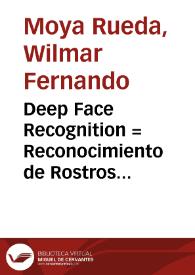Deep Face Recognition = Reconocimiento de Rostros usando herramientas de aprendizaje de máquina
Contenido de la obra
Contenido de la obra
Registro bibliográfico
Registro
- Título: Deep Face Recognition = Reconocimiento de Rostros usando herramientas de aprendizaje de máquina
- Autor: Moya Rueda, Wilmar Fernando
- Publicación original: 2016
- Descripción física: PDF
-
Nota general:
-
Face recognition is a specific case of object recognition. It has received special attention in the recent years due to a great variety of applications such as robot-human interaction, control by gesture, surveillance, security, and people tracking. The idea of face recognition is to give a computer system the ability of finding and recognizing human faces fast and precisely in images or videos. Face recognition aspires to work similar to human perception. Humans identify a big number of known faces, even after years of separation, or under extreme occlusion conditions, e.g. just by looking at a small part of a face. It is a complex task since faces can have different colors, poses, expressions, and sizes or they can be affected by illumination variations or occlusion conditions. Today, there are different methods of face recognition: feature-based approaches (low-level analysis, feature analysis, active shape models) that make explicit use of facial-features such as skin color, facial landmarks or face geometry, and image-based approaches (linear subspace models, neural networks, statistical approaches).
The recent increase in the volume of data and computational resources has led to the need for fast and scalable recognition techniques. These techniques should be robust to non-rigid deformations, clutter, occlusion and illumination variations, but, at the same time, they must be sensitive to variations among faces from different persons. For these reasons, neural networks have become a surge of interest Initially, shallow regular neural networks could be used for small image sizes, but they would not scale to deeper networks since a huge amount of parameters would be necessary to be learnt, which can easily cause overfitting. As a result, Convolutional neural networks (CNNs) were proposed. In a CNN, neurons in a layer are connected to small regions of previous layers, which is different to regular neural networks, where all neurons are connected in a full manner. Besides, CNNs make correct assumptions about the nature of the images, for example locality of pixel dependencies \cite{ImageNet}. In general, CNNs have fewer connections and parameters, they are easier to train, and they present similar or better performance than the regular neural networks \cite{ImageNet}. As an extension of the CNNs, deep CNNs were introduced by Imagenet authors because a big number of high-resolution images and powerful GPUs are now available. The authors increased the number of convolutional layers, and they use large receptive fields in the first convolutional layer. As a result, overfitting, which is inherent to the large size of the model, is avoided and effective results are achieved. In addition, the authors of the VGGnet continued adding convolutional layers, but they keep the size of the receptive fields very small (3x3 convolutions) with a stride of 1, throughout the whole network, which decreases the amount of parameters.
-
Face recognition is a specific case of object recognition. It has received special attention in the recent years due to a great variety of applications such as robot-human interaction, control by gesture, surveillance, security, and people tracking. The idea of face recognition is to give a computer system the ability of finding and recognizing human faces fast and precisely in images or videos. Face recognition aspires to work similar to human perception. Humans identify a big number of known faces, even after years of separation, or under extreme occlusion conditions, e.g. just by looking at a small part of a face. It is a complex task since faces can have different colors, poses, expressions, and sizes or they can be affected by illumination variations or occlusion conditions. Today, there are different methods of face recognition: feature-based approaches (low-level analysis, feature analysis, active shape models) that make explicit use of facial-features such as skin color, facial landmarks or face geometry, and image-based approaches (linear subspace models, neural networks, statistical approaches).
- Notas de reproducción original: Digitalización realizada por la Biblioteca Virtual del Banco de la República (Colombia)
-
Notas:
- Resumen: Convolutional Neural Networks; Face recognition; Face identification; Neural Networks; Deep Learning; Machine learning; Pattern recognition
- Derechos reservados del autor
- Colfuturo;
- Forma/género: tesis
- Idioma: inglés
- Institución origen: Biblioteca Virtual del Banco de la República
-
Encabezamiento de materia:
